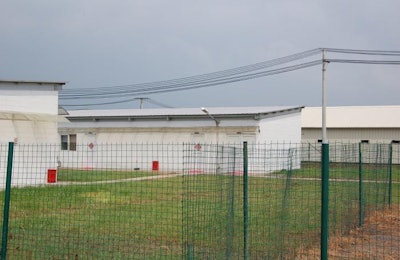
With the fall migratory season beginning in North America, farmers should take stock of their farm’s biosecurity and consider steps to improve it.
On September 15, WATT Global Media hosted a webinar on biosecurity and its role in defending farms against future outbreaks of highly pathogenic avian influenza. Dr. Mueez Ahmad, technical support veterinarian for Neogen Corp., and Dr. Gregory Martin, educator and extension specialist at Pennsylvania State University Cooperative Extension, shared their views on establishing a sound biosecurity program and minimizing risk to flock health and financial performance. Watch the on-demand webinar, Biosecurity, your poultry's defense against avian flu, which was sponsored by Neogen and BASF SE.
Biosecurity risk assessment
Biosecurity is about minimizing the risk of infectious agents interrupting farm performance, Ahmad said. Diseases are everywhere and the threat is constant, so biosecurity should be seen as an investment to block numerous vectors from interfering with a successful poultry operation.
A biosecurity system is based on three major components:
- Conceptual biosecurity, or the physical separation of production units.
- Structural biosecurity, designing a farm around disease prevention strategies and establishing a virtual or physical line of separation.
- Procedural biosecurity: the day-to-day practice of sanitation, disinfection and continuous education of farm workers and managers on good biosecurity practices.
Ahmed said all biosecurity programs should be based on risk assessment and tailored to the operation. Biosecurity guidelines available from national, state and local veterinary authorities are valuable, but they are guidelines not laws. Each farmer should consider the weak links and gaps in their own biosecurity and design their program around them.
Limiting risk means understanding and controlling disease vectors. Rodents and insects must be controlled, but humans are the greatest potential disease carriers and vehicle traffic control must be a major part of a biosecurity plan. Equipment that moves from farm to farm, including vehicles, must be cleaned and disinfected to limit disease transmission. Water sources can also host diseases – Ahmad said recent studies indicated avian influenza can survive in water for 150 days – so it must be considered a biosecurity risk as well, especially if the water comes from a surface level source. Airborne disease transmission, while hard to control, must also be considered a potential risk factor in farm design.
Creating lines of separation, such as the Danish system for entering and exiting poultry housing and production areas, and cleaning and disinfection of tools, people and clothing are key to limiting risk, Ahmad said. But a key part of those procedures, footbaths for workers, may be a weak link.
Ahmad said recent studies showed powdered disinfectants, which only cover the sole of the shoe are not as effective as formulated liquid products that cover the entire foot. Although these products are more effective, they can take 10 minutes or more to work fully so farmers are not using them. The best solution may be using separate footwear for production areas and routinely scrubbing and disinfecting those shoes using liquid disinfectant products. Color coded boots can help increase the effectiveness of this plan.
Continual improvement in operational biosecurity
Martin’s presentation focused on the day-to-day challenges of biosecurity and how farmers can ask themselves some pointed questions to help draft a more effective strategy.
Operational biosecurity should focus on establishing three disease barriers on the farm: a physical barrier, keeping disease and its vectors from making contact with the animals; a chemical barrier, killing the disease whenever possible by way of sanitation; and a logical barrier, ensuring farmers establish the correct management processes to minimize disease risk.
When farmers are drawing up their biosecurity plan, they need to consider the following:
- Lines of separation: Placement of areas where disinfection will occur. If a farm has more than one operation, livestock, crops, etc. on a single site, special attention must be paid to these areas.
- Entry and exit points: How personnel arrive and leave the farm and how it can be controlled to ensure all visitors and equipment are as clean as possible when arriving. Martin said farmers need to think about regular visitors, like family, business contacts and delivery drivers, as potential disease vectors. Only necessary personnel should be allowed on the farm, he said, and business meetings should take place off-site.
- Clean vehicles before they arrive: Martin said farmers should ensure cars are being washed in between visits. For farm vehicles, he said rubber floor mats should be used because they are easier to clean. He also suggested people regularly traveling between farms keep disinfectant in their vehicles.
- Keep rodents and other vermin out of the house: Close routes for rodents and other vermin to access the production area. Martin said grass, if there is any near the house, should be kept short to discourage rodents or totally removed.
- Making a large enough space for the Danish system to work properly: Martin said the Danish system, an anteroom room separating a “clean” interior of the production area – like the chicken house – from the outside, requires a good amount of space to really work. He said some farms are building specific facilities to store and change from clean and dirty footwear because systems wedged into existing structures at the farm are not large enough for the system to prevent contamination.
- Washing the floor: Martin said floors inside the chicken house must be washable or be refinished to be made washable. Regularly removing the grime from the floor through mopping, sweeping and cleaning cuts down on the “background noise” of viruses and bacteria living in the house.
- Managing air flow to ensure cleanliness: Martin said fans should be oriented so air from the house, with dirt and dust, is blown outside the house, or at least away from the clean areas of the house like the Danish system antechamber or the showers.


















